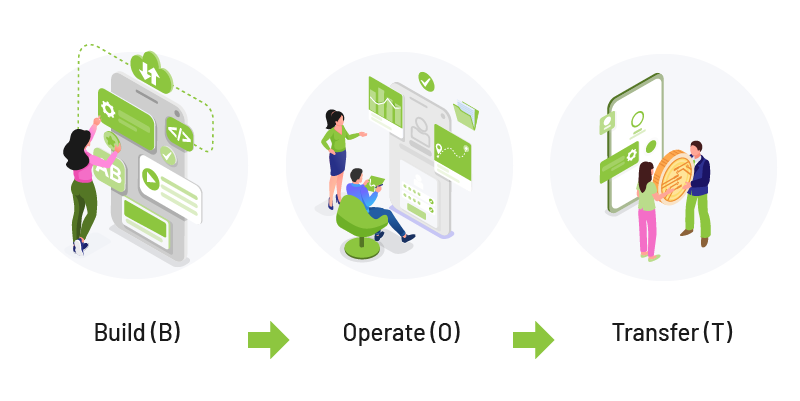Software outsourcing involves hiring external firms or individuals to handle software development tasks. The benefits of software outsourcing are numerous. They include cost savings, access to global development talent, and enhanced core focus.
How much does it cost to outsource software development? Well, rates can vary. In Asia, it’s about $35-40 per hour. Yet, it ranges from $40 to $70 in the USA.
Outsourcing remains a vital strategy for many businesses. Recent trends suggest this will only increase. Yet, software outsourcing costs are justified by its immense advantages. You’ll notice it as companies navigate the world of digital transformation.
The demand for specialized technology skills is rising. Some top skills include artificial intelligence (AI), the Internet of Things (IoT), and blockchain. However, finding these skills locally can be challenging. Outsourcing helps by opening up a global expert talent pool.
As the digital landscape evolves, software development outsourcing becomes a strategic tool. It lets businesses innovate swiftly and operate more dynamically. Also, it’s an essential component of modern business strategy.
Main Factors Affecting Outsourcing Costs
Various factors influence outsourcing prices. Understanding this fact is crucial for any business considering this approach. Here, we explore five key factors that impact the overall cost of outsourcing software development.
1. Geographic Location
The location of your outsourcing partner can significantly affect outsourcing rates, a factor outlined in offshore rates by country. This variation is mainly due to differences in economic conditions, labor costs, and market saturation. Outsourcing to countries in Eastern Europe, Asia, or Latin America can often be more cost-effective compared to hiring developers in North America or Western Europe. Additionally, differences in time zones, while complicating coordination, offer the advantage of enabling round-the-clock work cycles.
2. Complexity and Scope of the Project
The broader and more complex a project is, the higher the costs involved. A clearly defined scope helps in accurate budgeting. Also, it prevents scope creep, which leads to additional expenses. Complex projects may necessitate more frequent updates and iterations. Sadly, this adds to the overall timeline and financial commitment.
3. Types of Outsourcing Models
Different outsourcing models cater to varying project needs. Each has its advantages, disadvantages, and cost structures. These models are designed to suit different types of projects and client requirements, providing flexibility. They determine how companies manage and execute their software development needs.
Staff Augmentation
Staff augmentation is a flexible outsourcing strategy. It allows companies to add skilled technical resources to their existing teams. This model is ideal for projects that need specific skills that are absent internally.
– Pros: Staff augmentation enhances your team with specific skills, allowing high control over the development process and maintaining project continuity.
– Cons: This approach can be as costly. Hiring local talent due to similar hourly rates, and integration with the existing in-house team may take time. This slows the initial progress.
– Cost Structure: Costs are charged at an hourly or daily rate. It reflects the salaries of the temporary employees, making it easy to scale up or down. It doesn’t necessarily reduce costs.
Dedicated Development Team
The dedicated team model provides companies with a team of full-time professionals. They are located at the provider’s location. Also, this team acts as an extension of the client’s in-house development team.
– Pros: Offers a team that’s solely focused on your project. This makes it ideal for long-term projects with scopes that may evolve over time.
– Cons: This model offers less chance to reduce the team size on short notice. It may involve additional management overheads.
– Cost Structure: Generally invoiced monthly based on team size and skill set. This model creates predictable costs. It also ensures that the team is fully dedicated to the client’s project.
Offshore Development Center (ODC)
An ODC is an extension of a company located in another country. It provides integrated, long-term support for software development, testing, and other IT functions.
– Pros: Provides complete control over a dedicated facility and workforce. It can be cost-effective for large-scale, long-term projects.
– Cons: This model requires a high initial investment and a complex setup. Also, it has effective remote management capabilities.
– Cost Structure: Involves an initial setup cost followed by ongoing operational expenses. It offers significant potential for long-term savings due to lower costs.
Fixed-Price Model
This model involves hiring an external business to handle an entire project. They work from start to finish under agreed-upon terms. It’s best suited to projects with well-defined requirements and deliverables.
– Pros: This model offers a fixed price. It simplifies budget management and provides a clear output.
– Cons: It offers limited flexibility for changes. Any significant change requests can lead to higher costs.
– Cost Structure: The cost is usually a one-time fixed fee. This is agreed upon before the project starts. It helps in managing budgets without the worry of escalating costs.
By choosing the appropriate outsourcing model, businesses align their project needs with their strategic goals. It optimizes both costs and operational efficiency.
4. Technology Stack and Expertise
The choice of technology stack can greatly influence development costs. New or niche technologies such as AI may come with a premium due to needing experienced professionals. The more complex or cutting-edge the technology, the higher the expense.
Furthermore, the need for specific expertise can limit your choices of outsourcing partners. It drives up the price if only a few firms can meet your requirements.
5. Equipment and Software Costs
The infrastructure and tools required for project development play a critical role in costs. Software licenses, secure communication tools, and high-performance hardware all add up. It influences the total financial outlay for the project.
Additionally, some projects may require specific compliance or security measures. It involves further investments in technology to ensure data protection. By considering these factors, businesses can better plan their budgets. It lets them choose the right outsourcing strategies to meet their needs while controlling costs.
Software Development Rates by Country
Understanding global software development rates is crucial for businesses considering outsourcing. These rates vary depending on the region. Mainly, factors like local economic conditions and skilled developers impact costs. Market demand also plays a role. Here, we explore the average rates and pros & cons of outsourcing in different regions.
| Region | Average Hourly Rate | Popular Countries |
| Europe | $30-$70 | Ukraine, Poland, Romania, Bulgaria, Czech Republic, Hungary, Slovakia, Belarus, UK, Switzerland |
| North America | $50 to $150 | USA, Canada |
| Latin America | $30-$50 | Argentina, Mexico, Brazil, Colombia, Peru, Chile |
| Africa | $20-$40 | South Africa, Morocco, Nigeria, Kenya, Egypt |
| Asia | $25-$40 | India, China, Indonesia, Philippines, Vietnam, Pakistan, Malaysia, Bangladesh, Singapore |
| Oceania | $50 to $100 per hour | Australia, New Zealand |
Asia
Average Software Development Rates in Asia
In Asia, software development rates range from $25 to $40 per hour. Key countries like Vietnam, India, and Singapore offer competitive outsourcing rates. This region is attractive for cost-sensitive projects. It offers affordable solutions without compromising on quality.
Pros & Cons in Asia
Pros:
– Cost-effective rates help manage software outsourcing costs efficiently. It makes Asia a top destination for startups and established businesses.
– Large pool of talented developers handling diverse software projects. Countries have become global IT hubs.
– Rapid development pace reduces time to market for new software applications. This is crucial in today’s fast-paced tech landscape.
Cons:
– Variability in code quality can be a concern. Some regions have a reputation for lower-quality outputs, which might require additional oversight.
– Communication barriers due to language differences. It affects project timelines and outcomes, and clear contact strategies are needed.
– The significant time zone differences can pose challenges for real-time collaboration. This can also be leveraged for round-the-clock development.
Oceania
Average Software Development Rates in Oceania
Australia and New Zealand have higher software development rates ranging from $50 to $100 per hour. This reflects the higher cost of living and the economic development of these countries. So, it translates into higher wage expectations.
Pros & Cons in Oceania
Pros:
– High-quality standards with a strong emphasis on compliance and security. The region is ideal for projects requiring stringent data protection.
– Cultural and linguistic alignment with Western markets. It’s beneficial for companies in the US and UK. Also, it facilitates smoother project management and integration.
– Advanced technical skills and innovative approaches to software development. This ensures that businesses can access leading-edge technology expertise.
Cons:
– The higher cost of outsourcing may not fit all budgets. Smaller enterprises or startups might be limited in these markets.
– Less significant time zone differences can still affect businesses based in North America or Europe. This complicates scheduling and real-time contact.
Americas
Average Software Development Rates in the Americas
In the Americas, particularly in the USA and Canada, rates vary widely but generally fall between $50 to $150 per hour. These rates reflect the high skill level and technological advancement found in North American developers, which command premium pricing.
Pros & Cons in Americas
Pros:
– Access to a large number of highly skilled professionals with expertise in cutting-edge technologies, providing businesses with top-tier talent.
– Strong intellectual property laws ensure better protection of digital assets, offering security and peace of mind for companies outsourcing their development.
Cons:
– High outsourcing prices can be prohibitive for many companies seeking cost-effective solutions, making it less attractive for budget-sensitive projects.
– The competitive market means securing the best talent quickly can be challenging, requiring companies to act fast and offer competitive terms.
Europe
Average Software Development Rates in Europe
In Europe, rates can range from $30 to $70 per hour, with countries like Poland, the UK, and Switzerland offering a broad spectrum of skills and rates. Eastern European countries often provide more competitive rates and are famous for outsourcing due to their blend of affordability and high skill levels.
Pros & Cons in Europe
Pros:
– High-quality development standards and robust work ethics, combined with a solid educational foundation, provide a reliable outsourcing option.
– Significant pools of highly educated developers in countries with robust technical education systems contribute to a rich talent pool that is attractive to international businesses.
– Favorable time zones for companies based in Western Europe and the East Coast of the US facilitate smoother coordination and collaboration.
Cons:
– Outsourcing costs can be higher in Western European countries compared to Eastern Europe, reflecting the economic disparities within the region.
– Regulatory and bureaucratic hurdles can vary significantly by country, affecting the ease of business operations and requiring companies to be adaptable and well-informed.
Top Strategies for Managing Development Outsourcing Costs
Optimizing outsourcing costs is essential for businesses. This is especially true when implementing large-scale software solutions. This part of our guide at Saigon Technology provides proven strategies that help reduce costs. Don’t worry; you won’t sacrifice software quality. Here’s how you can make your software development process both cost-effective and efficient.
1. The Importance of Requirement Analysis
The saying “Well begun is half done” is particularly true in enterprise software development. At Saigon Technology, we stress that the initial phase of analyzing what the software needs to do is crucial.
Properly analyzing requirements not only sets the project up for success. It significantly helps in reducing costs.
Clear Requirements
Starting development quickly might seem like a good idea to save time and money. However, this can lead to adding too many unplanned features, which increases both the budget and the timeline. On the other hand, having a clear, documented set of requirements acts like a map. It reduces confusion and avoids expensive changes later.
Prioritizing Features
The MoSCoW method is a technique for prioritization used in project management. It ranks the importance of various features or tasks. This method divides features into four categories:
– Must-have: These are essential features that the project requires for successful deployment. Without these, the project cannot be considered complete.
– Should-have: Important but not critical features that enhance the project but can be delayed if necessary.
– Could-have: These are desirable features that are not vital for launch. They can be included if time and budget allow.
– Won’t-have (for this time): Features that are least critical and are not planned for this phase of the project but could be considered in the future.
Using the MoSCoW method ensures that the project focuses on essential features first. It helps manage the budget and resources more effectively. By categorizing the importance of each feature, teams can allocate their efforts wisely. It ensures that less important features are scheduled for later stages. This method provides a development roadmap, helping stakeholders understand where to invest their time and money.
2. Agile Methodology
At Saigon Technology, we support using the Agile method because it’s flexible and helps save money. This approach supports making changes throughout the project. That’s key for fixing issues early and avoiding big expenses later.
Iterative Development
Unlike traditional methods, Agile allows for continuous testing and updates. This early and frequent testing significantly reduces the costs and effort needed to fix problems later.
Sprint Planning
Good sprint planning helps keep the project within budget. It involves dividing the project into short phases and focusing on specific tasks in each phase. As such, it prevents overspending and ensures each phase delivers value.
3. Resource Management Techniques
Managing resources effectively is crucial to keeping costs down in software development.
Outsourcing
Using outsourcing is a cost-effective way to access skilled professionals without the costs of full-time staff. However, it’s essential to choose the best outsourcing partner. This avoids issues with communication and quality.
Skill Set Alignment
Assigning the right tasks to developers with the best skills leads to more efficient and higher quality outputs. At Saigon Technology, we make sure tasks match individual skills. It boosts productivity and reduces the need for expensive corrections.
4. Code Quality Assurance
Keeping code quality high is essential to avoid future costs from fixing errors.
Code Reviews
Regularly reviewing code helps catch errors early and enhances the team’s skills. Including these reviews in the Agile sprints ensures they help rather than hinder the development process.
Testing Automation
Automating tests for repetitive tasks reduces errors and frees up time for more complex issues. It improves the development process’s overall efficiency and cost-effectiveness.
5. Selecting the Appropriate Technology Stack
Choosing the right technology is key to controlling the initial costs and continual maintenance expenses. Here are some examples.
Open Source Software
Using open-source software can cut costs on licensing. At Saigon Technology, we recommend open-source options that are well-supported and maintained. It ensures they are reliable without hidden fees.
Cloud Computing Services
Cloud services can be cost-effective, especially for projects with changing needs. They allow you to pay only for what you use. However, it’s essential to manage these resources well to avoid unexpected high costs.
6. Effective Project Management
Good project management is central to reducing costs in software development. It depends on the project’s needs.
Kanban vs Scrum
Choosing between Kanban and Scrum depends on the project’s nature. Kanban is great for projects with ongoing tasks, while Scrum works well for projects that have distinct stages and complex requirements.
Budget Control
Using project management tools helps monitor the budget closely. The project stays within financial limits and achieves its goals without overspending.
Saigon Technology ensures that software development is affordable and practical. This helps our clients gain an edge in their markets.
Is IT cheaper to outsource IT?
Many companies employ the strategy of outsourcing IT functions. It aims to reduce costs and increase efficiency. However, whether IT outsourcing truly saves money can depend on several factors. It includes the nature of the projects, the size of the company, and the specific needs of the business.
Here’s a critical analysis of when and how IT outsourcing can be cost-effective.
Initial Cost Savings
Pros: A primary advantage of IT outsourcing is the potential for initial cost savings. Companies can save on hiring, training, and maintaining an in-house IT staff. By outsourcing, they pay only for the services they need when they need them. It saves on ongoing expenses with full-time employees such as salaries, benefits, and workspace.
Cons: The initial setup costs for outsourcing can be lower, sure. Yet, transitioning IT services to an external provider can involve hidden costs. These might include the expenses related to contract negotiation and transitioning services. Also, any potential downtime can affect productivity.
Scalability and Flexibility
Pros: Outsourcing IT allows businesses to scale their operations based on demand. This flexibility is precious for companies experiencing fluctuating or seasonal workloads. Also, outsourcing contracts can be adjusted to accommodate changing needs. It’s far more efficient than hiring or laying off in-house staff.
Cons: There can be limitations depending on the contract terms with service providers. Sometimes, scaling services incur additional charges. There might be limits to how much a service can be scaled down, leading to paying for unused services.
Access to Expertise
Pros: Outsourcing IT functions gives businesses access to a broader pool of expertise and the latest technologies. It which might be expensive to develop this in-house. IT service providers have specialized knowledge that leads to more innovative solutions.
Cons: Reliance on external expertise can make a company dependent on the outsourcing provider. It has the potential of the provider failing to deliver the expected results. Alternatively, contractual disputes may arise. In-depth knowledge of company-specific challenges might be lacking compared to in-house teams.
Long-Term Financial Impact
Pros: Outsourcing can lead to substantial financial savings in the long-term. Companies avoid costs associated with the continuous upgrading of technology and training of staff. It can also convert fixed IT costs into variable costs, tying expenses to requirements.
Cons: Long-term reliance on an outsourcing provider can lead to increased prices over time. The provider can become ingrained in the company’s IT processes. Also, negotiating contracts as a dependent customer can weaken a company’s bargaining position. It can result in higher costs in the long run.
Risk Management
Pros: Outsourcing IT functions can reduce the risks associated with technology failures. Providers offer high standards of security. Moreover, they are equipped to manage recovery and backups with more efficiency than many in-house teams.
Cons: Outsourcing introduces risks in data security and privacy. There’s a concern about third parties handling sensitive information. Companies must ensure that their outsourcing partners comply with all security regulations.
IT outsourcing is often more cost-effective than maintaining in-house operations. This is especially true for small to medium-sized enterprises needing to scale their operations quickly.
However, it requires careful consideration of the provider’s capabilities. Contract terms need to be clear. Also, there needs to be a thorough understanding of the company’s specific IT needs. Effective outsourcing is about finding the right balance between cost savings and maintaining IT control.
Why Partner with Saigon Technology for Your Software Development Needs?
Opting for Saigon Technology, an affordable outsourcing company, means you are partnering with a firm that not only helps optimize your project costs but also deeply understands your business needs across different sectors, backed by their experience in over 800 successful projects.
Whether you’re starting a new venture or heading a multinational corporation, Saigon Technology has the right tools to realize your digital dreams. Contact us today to learn how we can assist you.
Concluding Thoughts
Outsourcing software development offers significant cost benefits by eliminating the overhead associated with maintaining an in-house development team. Companies gain access to a global talent pool, which allows for flexible scaling of resources and access to highly specialized skills at a lower cost than may be available locally. Additionally, outsourcing provides flexibility to adjust project scopes and resources as business needs change, making it an attractive option for dynamic industries.
However, to truly capitalize on these advantages, businesses must manage potential hidden costs such as transitioning, contract management, and communication barriers. Effective partnership with a reliable outsourcing provider requires clear communication and precise project definitions to avoid unexpected expenses. With the right approach, outsourcing can not only be cost-effective but also enhance quality and innovation, leading to long-term business success.
FAQs
How much does the average software development project cost?
The cost of a software development project varies widely depending on factors like project complexity, scope, technology stack, and team composition. On average, small projects may range from a few thousand dollars, while larger enterprise-level projects can exceed several hundred thousand dollars or more. On average, you can expect somewhere between $50,000 to $250,000 for medium projects, if not more. Large projects can scale up to $1,000,000.
How are outsourcing costs calculated?
Outsourcing costs are typically calculated based on factors such as the hourly rates of developers, project duration, and any additional expenses such as infrastructure or licensing fees. By estimating the time required for each task and multiplying it by the hourly rate, you can derive the overall outsourcing cost.
What are the hidden costs of outsourcing?
While outsourcing can offer cost savings, there are potential hidden costs to consider. These may include communication challenges, time zone differences, cultural barriers, quality assurance expenses, and legal or contractual issues. It’s important to perform thorough due diligence and establish clear communication channels to mitigate these risks.














